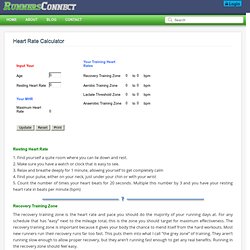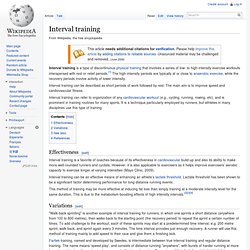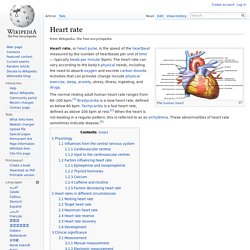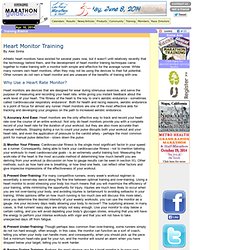

Top 10 Marathon Training Mistakes. From Running tips for everyone from beginners to racing marathons and ultramarathons The bitter taste of failure.

Photo by mzacha. I've split this list of the marathon of mistakes into those made on the race itself and those made in training. I focused on mistakes that a specific to the marathon distance, though there is obviously some overlap to other types of racing and running. The prioritization is based on the severity of the mistake combined with the likelihood of it happening. The Five Most Common Running Form Mistakes. By Brandon Laan, Published Jun. 12, 2013, Updated Jun. 14, 2013 at 7:58 AM UTC Are you making one of the following running form mistakes?

There is a lot of chatter surrounding proper running form in today’s running world, which makes it very difficult to discern which approach is appropriate or suitable for you. To make matters worse, we have witnessed the likes of Paula Radcliffe set world records with what looks like a hiccup in her stride and more recently, watched Meb Keflezighi win the U.S. Olympic Marathon Trials while displaying what some would argue is impeccable form. There are several top athletes and coaches doing their part to share proper running mechanics with the running masses. Somax Sports - Chris Solinsky Stride Analysis. How To Do a Tempo Run. Deciphering the Long Slow Distance Run (Part I) Photo by westpark A few people had asked me a while back to write about my approach to the LSD or the weekend long run but because I was busy with other things and was already contemplating a blog hiatus, I had let it slip my mind.

But after holding several rather lengthy discussions with my brother and a friend on the philosophy of “Running Slower to Run Faster”, I thought it would be best to “kill two birds with one stone” by explaining the physiology behind the long run and why you need to run them at the proper speed (which is usually slower than what most people would imagine) in order to reap the most benefits. Keep in mind that this lesson is geared more toward the beginning marathoner rather than the veterans out there so if anything I speak of here seems common sense or blatantly obvious, please realize that there’s an audience out there for whom this information is counter-intuitive and not so simple to understand.
Now that we’re all on the same page, let’s get started. Heart Rate Calculator - Runners Connect. Resting Heart Rate 1.

Find yourself a quite room where you can lie down and rest. 2. Make sure you have a watch or clock that is easy to see. 3. Pros and Cons of Running Twice a Day. Heading out for two runs in a single day--logging "doubles" or "two-a-days"--is standard practice among elites.

But most mortals wouldn't dream of it: not enough time and too much injury risk. "There is a misconception that doubles are something only high-mileage, elite runners do," says Steve Magness, an exercise physiologist and cross-country coach for the University of Houston. "But a lot of runners can benefit from them. " Including time-crunched folks trying to squeeze in miles and veterans looking to step things up. For good reason: Studies suggest doubling up and running in a depleted state can boost fat-burning, train the body to use glycogen more efficiently, and stimulate mitochondria production (more mitochondria can delay fatigue).
Little Time, Big Dreams"Cumulative mileage matters--no matter how you do it," says Brad Hudson of Hudson Elite Marathon Performance in Boulder, Colorado.
Hal Higdon Training Programs. Cycling songs named Megadeth (Page 1) Running form. Fartlek Training - What is Fartlek Training. Question: What is Fartlek Training?

Answer: Fartlek, a Swedish term that means "speed play," is a form of interval or speed training that can be effective in improving your speed and endurance. Fartlek running involves varying your pace throughout your run, alternating between fast segments and slow jogs. Unlike traditional interval training that involves specific timed or measured segments, fartleks are more unstructured. Work-rest intervals can be based on how the body feels.
With fartlek training, you can experiment with pace and endurance, and to experience changes of pace. To do a fartlek workout, try introducing some short periods of slightly higher pace into your normal runs. Once you complete a fast segment, slow your pace to below your normal running pace, until you have fully recovered and your breathing has returned to normal. Yasso 800, run 800, jog400 times 10. 6 x 800. 400 recovery after each. Interval training. Interval training is a type of discontinuous physical training that involves a series of low- to high-intensity exercise workouts interspersed with rest or relief periods.[1] The high-intensity periods are typically at or close to anaerobic exercise, while the recovery periods involve activity of lower intensity.

Interval training can be described as short periods of work followed by rest. The main aim is to improve speed and cardiovascular fitness. Interval training can refer to organization of any cardiovascular workout (e.g., cycling, running, rowing, etc), and is prominent in training routines for many sports. File:Exercise zones.png. Heart rate. Heart rate, or heart pulse, is the speed of the heartbeat measured by the number of heartbeats per unit of time — typically beats per minute (bpm).

The heart rate can vary according to the body's physical needs, including the need to absorb oxygen and excrete carbon dioxide. Activities that can provoke change include physical exercise, sleep, anxiety, stress, illness, ingesting, and drugs. Phil Maffetone, www.philmaffetone.com - 180-Formula. Heart Monitor Training. Heart Monitor TrainingBy Alex Sinha Athletic heart monitors have existed for several years now, but it wasn't until relatively recently that the technology behind them, and the development of heart monitor training techniques came together to make training with a monitor both simple and effective for the average runner.

While many runners own heart monitors, often they may not be using the devices to their full potential. Training with 5 exercise heart rate training zones - page 2. Page 1 2 3 Measuring Your Max HR Important note!

Before you self-test, please read the "Before Your Start" section at the end of this article. You won't reach your Max HR with these tests, but they give you a range within which your Max HR probably lies. Long slow runs. Let's hope you look as good as Grethe, Sue Ellen and Ron when you finish a 20 mile run. Long slow distance. Long slow distance (LSD) is a form of aerobic endurance training in running and cycling.[1][2] Physiological adaptations to LSD training include improved cardiovascular function, improved thermoregulatory function, improved mitochondrial energy production, increased oxidative capacity of skeletal muscle, and increased utilization of fat for fuel.[1] Ernst van Aaken, a German physician and coach, is generally recognized as the founder of the long slow distance method of endurance training.[3][4][5] History[edit] Joe Henderson[edit] Henderson’s book was not only directed at competitive runners, but also at runners who wanted to have fun running.
He writes, “LSD isn't just a training method. It's a whole way of looking at the sport. Deciphering the Long Slow Distance Run (Part II) Photo by Ken Lund In the previous post, we discussed the basics of what a long run is and why it is important, at least on a practical level. Here, in this post, i’d like to expand on these concepts, talk about speed as it pertains to the long run and discuss why it is so important to run long runs at the appropriate pace to reap the most physiologic benefits.
Train up to 75% of race distance. The 10-Percent Rule. The 10-percent rule (10PR) is one of the most important and time-proven principles in running. It states that you should never increase your weekly mileage by more than 10 percent over the previous week. The 10PR gains its importance from the fact that the vast majority of running injuries are overuse injuries. McMillan Running - Calculator.